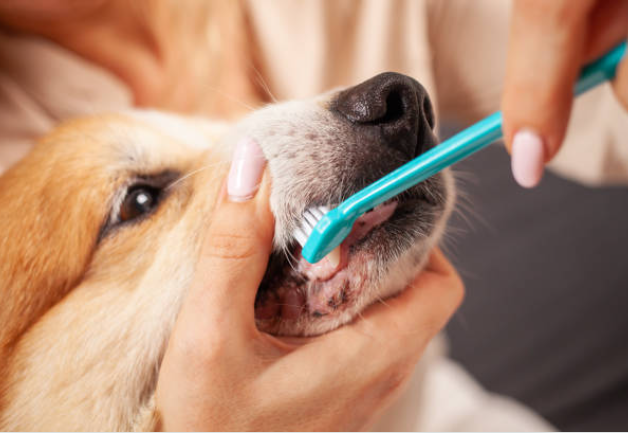If you’ve ever been hit by a blast of bad breath from your furry companion, you’re not alone. Dog parents often find themselves searching for quick fixes to freshen up their pet’s breath. Among these, a common question arises: Can dogs have Listerine strips?
Listerine strips, known for their breath-freshening properties, might seem like an easy solution. However, these products are not designed for dogs and can be harmful to their health.
In this article, we’ll explore why Listerine strips are unsafe for dogs, what makes them dangerous, and how to manage your dog’s bad breath safely and effectively.
Why Do Dogs Have Bad Breath?
Before addressing the question, Can dogs have Listerine strips? it’s important to understand the causes of bad breath in dogs.
While occasional bad breath is normal, persistent foul odor might indicate an underlying problem.
- Dental Issues
- The most common cause of bad breath in dogs is dental disease. Plaque and tartar buildup, gum infections, and cavities can all lead to unpleasant smells.
- Dietary Habits
- Some dogs eat things they shouldn’t—like trash, spoiled food, or even animal feces. These habits, known as coprophagia, can contribute to bad breath.
- Health Problems
- Bad breath might also signal more serious health issues such as kidney disease, liver problems, or diabetes.
- Foreign Objects
- Sometimes, small objects like bones or sticks can get lodged in a dog’s mouth, leading to infections and bad breath.
By identifying the cause, you can address the root of the problem instead of resorting to unsafe quick fixes like Listerine strips.

Can Dogs Have Listerine Strips?
No, dogs should not have Listerine strips. While these strips are great for refreshing human breath, they contain ingredients that can harm your dog.
Let’s break down why they’re unsuitable for pets.
- Toxic Ingredients
- Menthol: A key ingredient in Listerine strips, menthol is toxic to dogs. It can irritate their mouth and digestive tract, leading to symptoms like vomiting and nausea.
- Eucalyptol: Derived from eucalyptus oil, this ingredient can cause vomiting, diarrhea, lethargy, and even weakness in dogs.
- Polysorbate 80: While generally safe for humans, this emulsifier might trigger mild allergic reactions in dogs.
- Propylene Glycol: Known for its harmful effects on dogs, this ingredient can cause digestive upset and toxicity.
- Not Tested for Dogs
- Listerine strips are formulated and tested for human use. There’s no safety data on their effects on dogs, which makes them a risky choice.
- No Long-Term Benefits
- Even if a Listerine strip temporarily masks bad breath, it doesn’t address the underlying cause. Persistent bad breath in dogs requires proper diagnosis and treatment.
What Happens if a Dog Eats a Listerine Strip?
If your dog accidentally eats a Listerine strip, monitor them closely for signs of toxicity, including:
- Vomiting
- Diarrhea
- Abdominal pain
- Lethargy
- Loss of coordination
- Depression
In severe cases, ingesting harmful ingredients like menthol or eucalyptol can lead to more serious complications.
Contact your veterinarian immediately if your dog exhibits any of these symptoms.
Are Other Human Breath-Freshening Products Safe for Dogs?
Just like Listerine strips, other human breath-freshening products are not safe for dogs. Products like mints, sugar-free gum, and mouthwash often contain xylitol a sweetener that’s extremely toxic to dogs.
Dangers of Xylitol:
- Xylitol can cause a rapid drop in your dog’s blood sugar, leading to symptoms like weakness, shaking, and seizures.
- In large amounts, it can cause liver failure and potentially be fatal.
If your dog consumes any product containing xylitol, contact your vet or a pet poison control hotline immediately.

Safe Ways to Handle Bad Breath in Dogs
Now that we’ve established why Listerine strips are off-limits, let’s explore safer and more effective ways to manage your dog’s bad breath.
- Visit Your Veterinarian
- Persistent bad breath often points to dental disease or other health problems. Your vet can examine your dog’s mouth, identify the cause, and recommend appropriate treatment.
- Brush Your Dog’s Teeth
- Brushing your dog’s teeth daily with a pet-safe toothpaste is one of the best ways to prevent plaque buildup and keep their breath fresh. Never use human toothpaste, as it contains ingredients like fluoride and xylitol that are harmful to dogs.
- Provide Dental Chews
- Dental chews are specially designed to reduce plaque and tartar while freshening your dog’s breath. Choose vet-approved chews for the best results.
- Use Dog-Safe Water Additives
- Some water additives are formulated to improve your dog’s oral health. These can be added to their drinking water and help reduce bacteria and plaque.
- Feed a Balanced Diet
- Poor-quality diets can contribute to bad breath. Ensure your dog is eating a nutritious, balanced diet to support their overall health.
- Inspect Your Dog’s Mouth Regularly
- Check for foreign objects or signs of infection. If you notice redness, swelling, or something stuck between their teeth, consult your vet.
Preventing Bad Breath in Dogs
Prevention is always better than cure. By adopting a proactive approach to your dog’s oral health, you can avoid bad breath and other dental problems altogether.
- Schedule Regular Check-Ups: Visit your vet for bi-annual check-ups to monitor your dog’s dental health.
- Provide Chewing Opportunities: Offer your dog safe toys or bones that promote natural teeth cleaning.
- Stick to Dog-Safe Treats: Avoid giving your dog table scraps or human food that can harm their teeth or contribute to bad breath.
Can Dogs Have Listerine Strips? The Final Answer
So, can dogs have Listerine strips? No, they can’t and they shouldn’t. These strips contain harmful ingredients like menthol, eucalyptol, and propylene glycol, which can cause serious health issues for your furry friend.
Instead of relying on unsafe human products, focus on proper dental care and dog-specific solutions to manage bad breath.
Regular brushing, dental chews, and vet visits are the safest and most effective ways to ensure your dog’s oral health.
Bad breath in dogs is more than just a nuisance, it can signal underlying health issues that need attention.
By addressing the root cause and using pet-safe products, you can keep your dog healthy, happy, and free from bad breath.
When in doubt, always consult your veterinarian before introducing any new product into your dog’s routine. Your pet’s health and well-being depend on safe, informed choices.
See also:
Are Dogs Allowed in Cemeteries?
How Long Does a Dog Grooming Take?

